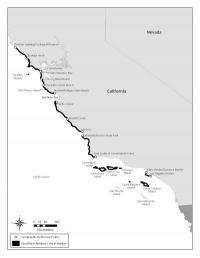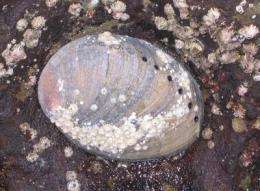NOAA designates critical habitat for black abalone

NOAA's Fisheries Service today filed with the Federal Register a final rule that identifies black abalone critical habitat along the California coast. In February 2009, black abalone was listed as endangered under the Endangered Species Act, and the Act requires critical habitat be designated, to the maximum extent prudent and determinable, whenever a species is listed for protection.
Once areas are designated as critical habitat, federal projects or permits and projects with federal funding are required to ensure their actions do not adversely modify the animal's habitat. Designating critical habitat does not affect citizens engaged in activities on private land that do not involve a federal agency.
Since the 1980s, the black abalone population has plummeted primarily from a bacterial disease known as withering syndrome. The impacts of withering syndrome may have been worsened by the warming of coastal waters from long-and-short-term changes in climate or from power plants' discharge of warm water. Other causes that likely contributed to the decline in black abalone populations are historical overfishing and poaching.
Black abalone once existed in intertidal waters from the northernmost reaches of California to the southern tip of the Baja peninsula in Mexico. The edible marine snail was harvested from the mid-1800s, and peaked in the 1970s as a commercial fishery in California. Today, the species is rarely found north of San Francisco or much farther south than the California-Mexico border.

Using agency data and information provided by the public, NOAA's Fisheries Service designated critical habitat for black abalone along the California coast to include rocky habitats, and the coastal marine waters above the benthos from the mean higher high water (MHHW) line, or average high tide, to a depth of six meters (approximately 20 feet) in the following areas (see attached map):
- From Del Mar Landing Ecological Reserve to Point Bonita.
- From the southern point at the mouth of San Francisco Bay to Natural Bridges State Beach.
- From Pacific Grove to Cayucos.
- From Montaña de Oro State Park to just south of Government Point.
- Palos Verdes Peninsula from the Palos Verdes/Torrance border to Los Angeles Harbor.
- The circumference of: the Farallon Islands; Año Nuevo Island; San Miguel Island; Santa Rosa Island; Santa Cruz Island; Anacapa Island; Santa Barbara Island; and Santa Catalina Island.
NOAA's Fisheries Service excluded the area of rocky habitat from Corona Del Mar State Beach to Dana Point from the designation, because the economic benefits of exclusion outweigh the benefits of inclusion, and the exclusion will not result in the extinction of the species. It was also determined that San Clemente Island and San Nicolas Island were no longer eligible for designation due to the development of integrated natural resources management plans that provide benefits to black abalone.
Provided by NOAA














